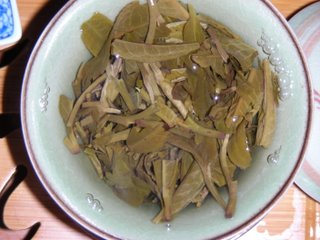My obsession with tea has been transcending from drinking just because it's a custom, to Kung Fu tea, to tea art, to history, until tonight, Chinese tea influence by market share.
I spent a few hours searching for tea related articles in the Chinese sites, which I usually hate because of all the flash, popping icons, annoying music and more colors than a rainbow designs. I found one article that's quite inspiring. China is #1 in tea growing land space, #2 in tea production, #3 in tea exporting, #4 in foreign money earning by tea trade. China is at an embarrassing situation where it's the largest tea country yet not the strongest in market share. The unknown author pointed out 5 mistakes China tea industry make in promoting/marketing tea globally.
1. Branding. European successfully brand and market a product that not a leave is grown on its soil, however China operations are still "mom and pop" operated. Corporate management is still at its youth in China. There isn't a financially strong enough corporation to brand its name globally. The Chinese government should play a major role in establishing a foundation for the country's sake, rather than numbers of small players trying to make a dot in the global market. Sort of like the Farmer's association here in America, uniting individual farms to organize/control production, implement central marketing strategy, gathering and transporting. "Got milk?", "Pork is the other white meat!"! Something to learn from eh.
2. Positioning. Since the 80's, Chinese tea faced strong competition of coffee, juice, and bottle water, all relatively young drinks comparing to thousands years old tradition. For over 4 thousand years, tea is an irreplaceable item in China, its position is determined by consumer, tradition and culture. We can achieve that globally, not as a fashionable trendy thing, but a necessity household item as well.
3. Art over business. Instead of promoting tea on a pedestal, it should be an everyday practical necessity, ie "English breakfast". Something that everyone enjoys on a daily basis without digging a whole in a wallet. Many middle class American can bare an inflated tea price, however $30/lb tea would deter a buyer away compare to a box of tea bags for a mere $1.99 at supermarkets. Successful marketing is conquer market share. I have never seen a Jasmine tea bag at even the finest non-Asian cuisine restaurants in the states where it's free and mandatory at neighborhood Chinese restaurants. Chinese promote tea as an art, a way of living, yet it's just an other consumer product in eyes of the westerners. India the #1 tea exporter exports Darjeeling to the top 10 tea merchants in the world, 99% low grade tea. It's not a refined "art" they are trading.
4. Sales over specialty/quality. Many producers produce according to market trend, something sells well in the market, within 6 months, 5000 more producers are making the same tea. For example, pu-erh is reviving in the last 10 years, you see all kinds fake products surfacing on the market. The mind set of Chinese business men are focusing on how much money one can make at this moment, rather than developing a consistent line of products and create an identity for itself.
5. Market planning/investing. China tea export business is still at shipment by shipment opportunistic mentality. What it takes is a marketing plan to promote tea as a necessity, not follow market trend, nor a trend either. More than 3 hundred years ago, Chinese tea became known to the western world, however Indian tea is the household item today. That's the power of marketing of laying a foundation for a product. It requires a tremendous amount of time and financing to conquer market share.
Living in America and having limited available tea to this side of the globe, I felt it's a noble thing to do to promote the fine "art" of tea, putting my efforts to spread the Chinese tea culture no matter how alone I will be at this task. After reading this article, it's more than just satisfy one's indulgence, chasing that untouchable supremacy. In order to reach that cultural supremacy, one must not forget the baby steps, start from the basic, build a foundation first before reaching the top of the mountain. There is a need to reestablish Chinese tea's global position, we can all contribute with what we can, our knowledge, our passion and our belief. One day I'd be jumping in joy to find even just a bag of Lung Jing or Mao Jian in that nice tea box handed in front of me at any restaurants, be it French, Italian, and even better, a basket full of tea bags at Dennny's!!! It'd be amazing to see that happening during my life time.


















































